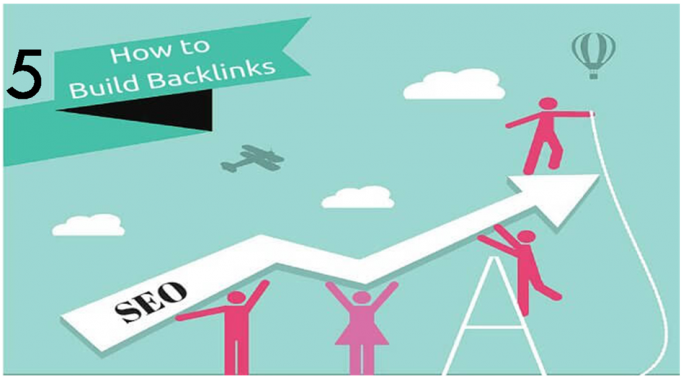How to Turn Around a Failing Facebook Ad Campaign
With over 2 million active advertisers on Facebook, you’ve probably read dozens of stories by now of how people are running profitable Facebook Ads.
But, what if you’re not experiencing success when it comes to Facebook Ads?
Does it mean that the whole notion of profitable Facebook Ads is a myth?
Of course not.
Your campaigns are most likely failing due to some fundamental errors that you’re making. Don’t worry, we’ve all been there.
Struggling with your Facebook campaign? Learn about 4 major problems and how you can solve them.
In this article, I’m going to cover some of the most common reasons that your Facebook Ad campaigns might be failing and what you can do to ‘resuscitate’ them.
Your targeting isn’t right
Facebook is a powerful advertising platform because you can target your ads in ways that just aren’t possible on other platforms. But, there’s a flipside to this.
If your Facebook Ads are failing, there’s a good chance that you’re not targeting your ads properly.
Why is improper targeting a problem?
If you’re putting your ads in front of people who don’t care about your offering, it doesn’t matter how good your ad is — people just won’t click on it.
When it comes to targeting errors, there are two camps that advertisers generally fall into.
The first camp includes people who make their targeting too narrow. This tends to happen when you go over the top with Facebook’s targeting features.
The second camp includes people who make their targeting too broad.
How do you know if poor targeting is your problem?
Generally, if you’re working on a brand new campaign with decent new ads and you’re targeting is not set up properly, your ads will have a low ‘Click-through-rate (CTR).’
CTR is calculated by dividing the number clicks by the number of times your ad was shown.
Poor targeting leads to a poor CTR because your ads are irrelevant to the people you’re showing them to. Because of this, they don’t feel like clicking on your ads.
Conversely, you might have a decent CTR, but very low volume. This is a common sign that your targeting is on the right track, but too narrow.
Remember — if no one’s clicking on your ads, your ads aren’t going to be making you any money.
If you want to dial in your targeting, there are a couple of things that you can do.
Create buyer personas
A buyer persona is a semi-fictional representation of your ideal customer, based on market research and real data about your existing customers.
A buyer persona will help you figure out who your ideal customer is, by asking questions like –
What demographics do they occupy? At the most basic level you need to know their age, gender, job title and geographical location.
What does a typical day in their life look like? When you know this, you’ll have a better understanding of what interests they have and what products they purchase.
What are their pain points? This will let you know what their main struggles are. You can then use this information when actually writing your ads, by suggesting that you can solve these pain points musik aus dem internet herunterladen kostenlos.
See the image below?
You need to come up with a buyer persona that’s so detailed, that you can easily decide on all of the relevant options provided by Facebook.

On the ‘More Demographics’ drop-down menu, you might want to stop short of Ethnic Affinity. Though the ‘Life Events’ section might be useful, the rest may cause you to target too narrow.
You might think that buyer persona’s are a waste of time, but it’s one of the things that Zappos used to help focus their $10 million (!) ad spend.
Though they called it ‘consumer profiles’, they essentially followed the same steps when they were creating buyer persona’s.
As your ads become more targeted, you’ll begin to notice that your ‘Potential Reach’ is getting lower. Reach refers to an estimated number of people who will see an impression of your ad.

When Reach falls, you’ll notice that the needle shown on the page where you actually create your ads will swing to the left.
How to Target by Analyzing Audience Insights

Audience Insights is a tool created by Facebook. In basic terms, you can use it to convert broad targeting data into narrow targeting data that is more likely to convert.
Even if you just provide the Audience Insights tool with a little bit of information, you’ll still get a lot more back in the form of data points that give you a sense of who your customer really is.
You can then use this information so that you can deploy Facebook’s targeting features to the fullest extent.
Let’s take a look at how you can use Audience Insights to improve your ad targeting.
(Note: The Household and Purchases section is only available in the US at the moment).
i) Combining Audience Insights with a Basic Buyer Persona
Audience insights can become an incredibly powerful tool, even if you just have the basics of your buyer persona down.
Let’s say that we wanted to create a Facebook Marketing course that taught people how to build an email list.
How could we use Audience Insights to provide us with information on who we should target?
Well, lets assume that we know some basic information about our potential customers.
For arguments sake, we’ll say that the buyer persona of our customers is the following:
- Age – 21-55
- Location – U.S.A
We’ll then put that information into the options provided by the Audience Insights tool.

When it comes to interests, I just entered some keywords that are related to the hypothetical product.
The keywords can be based on what you’re looking to sell, but also on people/companies that might be an authority in your space.
That’s because they tend to be going after the same audience as you.
Don’t know who these people or companies might be?
Fix this problem by doing a quick Google search on a keyword that is relevant to your offering. Here’s what I did –
I searched ‘list building Facebook ads’ (ignore the bad grammar).

Then, I started to see some big name websites like Social Media Explorer, that were relevant in this niche.

Hubspot too.

I also identified people who are influential in this niche. Amy Porterfield is an example.

So is Jon Loomer herunterladen.

I then put these websites and names into the targeting options.
You want to find the right balance here.
I’ve found that it’s between 5-7 interests. Too many and your data might miss some excellent targeting opportunities. Too little and your data will be too unspecific.
Keep in mind that you can only target interests on Facebook that have a large enough following.
Some of the names and websites I found on Google didn’t register when I tried to enter them in the interests section. That’s why they’re not there.
Lets take a look at what we discovered as a result of providing this information.

Right off the bat, we know that the audience size is around 700-800k. We just invented this audience right now, so that doesn’t mean much.
It does, however, give us a sense of what’s possible if we were to run ads to this audience. A lot of people means that we can advertise a lot without quickly saturating the audience with our presence.

We also know that the audience is also evenly divided between men and women.
Throughout this post you’ll notice that there are blue bars and grey bars. The grey bars compare the audience demographics to the rest of Facebook.
The grey bars for 55-64 and 65+ are at 0% because that age range was not included when I was formulating my audience.
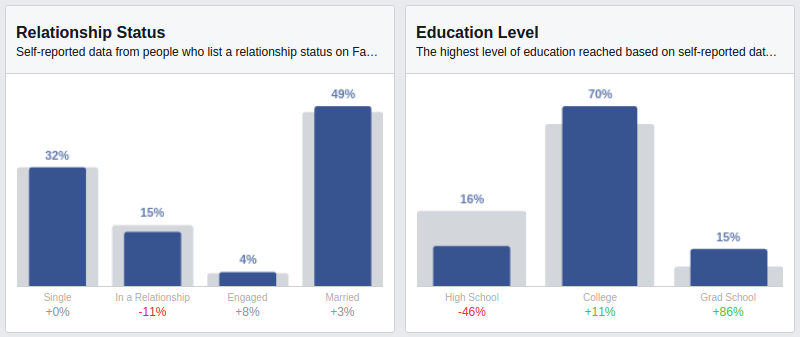
According to the insights provided, we can also infer that a statistically significant number of people in this audience are college graduates and are married or single.
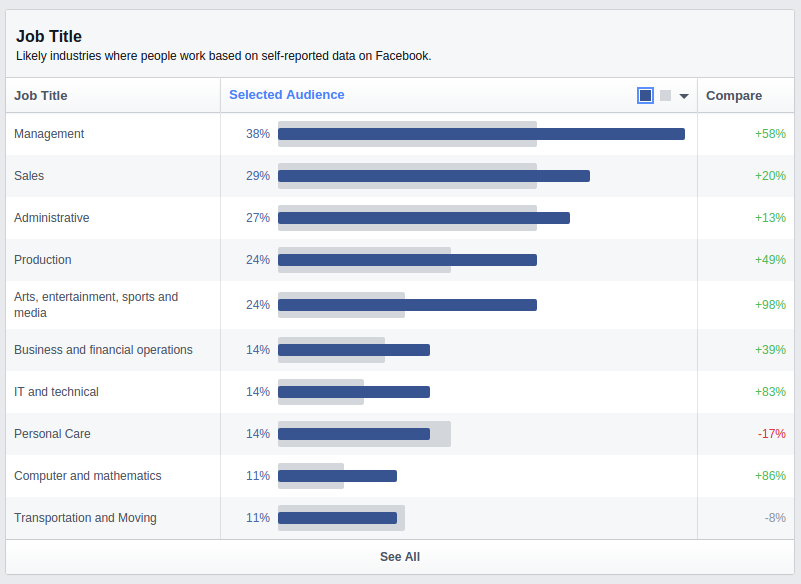
I can also tell that most of the people in this audience hold job titles related to management, sales and administration.
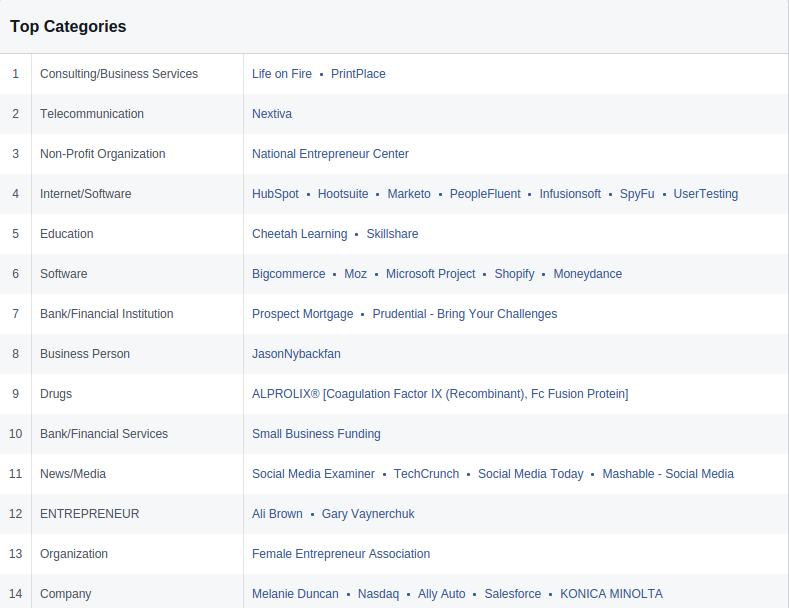
Above is an image of the Top Categories page. The ‘Top Categories’ page lets us know the top pages liked by people in this audience for each of the categories shown.
This is where you really begin to learn a lot. That’s because Facebook interest targeting is extremely powerful and this page lets us know what interests our audience has.
The image below shows a few more ‘Top Category’ pages liked by people in this audience.
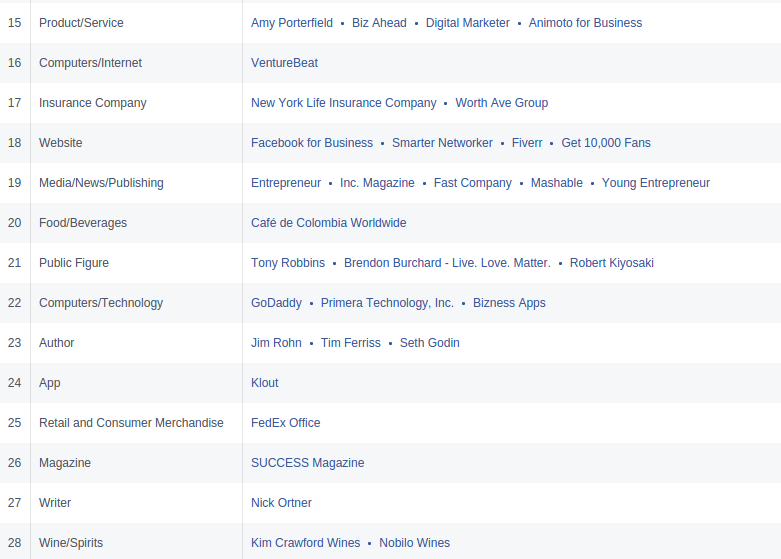
Here is some more information, based on the top pages liked in each category for this audience.
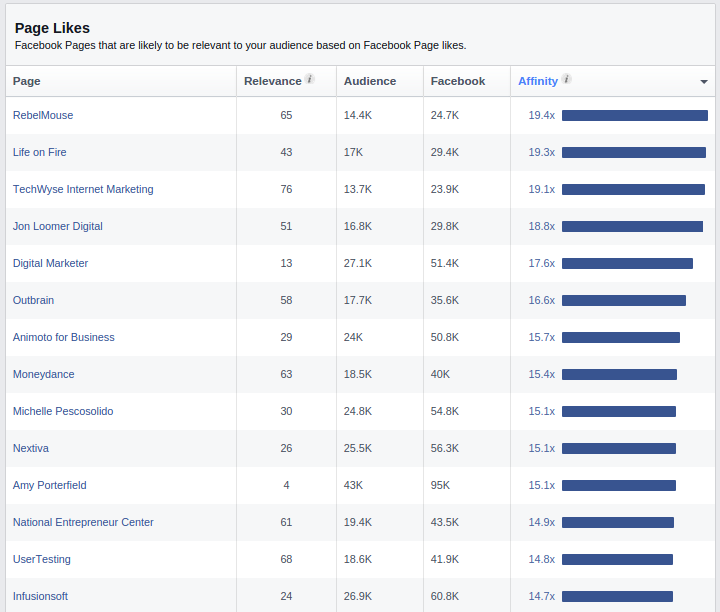
The ‘Page Likes’ section shows us some of the pages that are most relevant to our target audience.
The affinity column tells us how likely someone is to ‘like’ a certain page, compared to everyone else on Facebook. This lets us know about overlaps, in terms of what your target market might find interesting.
If you target the pages with high affinity, you increase the odds of targeting people who might be interested in your offering.
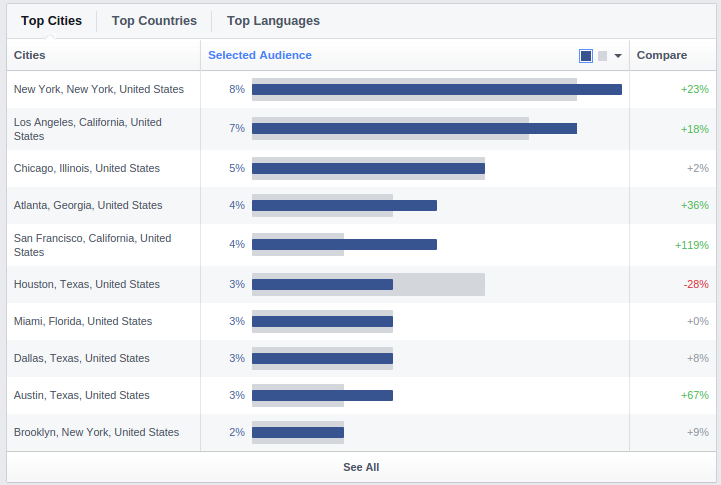
By looking at location, we can see where most of the target audience is located adware cleaner downloaden. A lot of them are located in New York, Los Angeles, Chicago, Atlanta and San Francisco.
The percentages in the compare column just translate into numbers what the two bar colors show. If you don’t remember, that’s how our ‘Selected Audience’ compares to the rest of Facebook.
As you can see, a disproportionate number of people in San Francisco are in this audience.
This makes sense as a lot of start-ups are in San Francisco. They’re probably running a lot of Facebook Ads to get users.
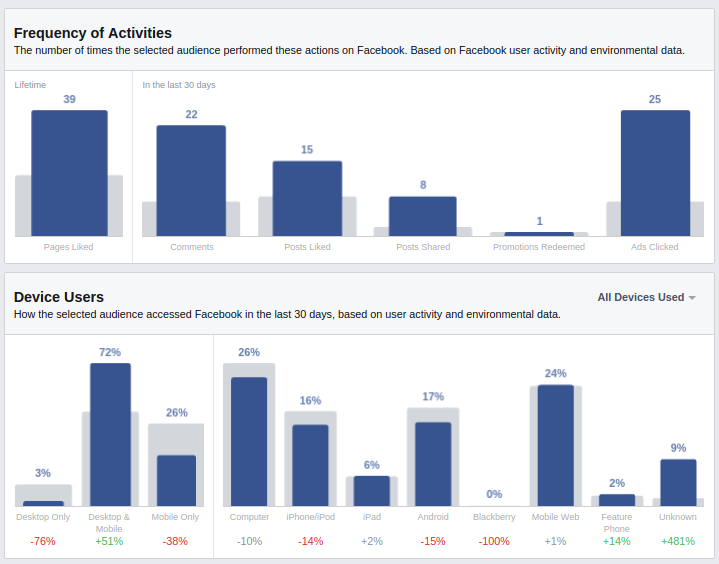
Here we can see that our target audience is accustomed to using Facebook on their desktop and mobile device. Very few of them, however, use mobile only. 76% less when compared to the rest of Facebook.
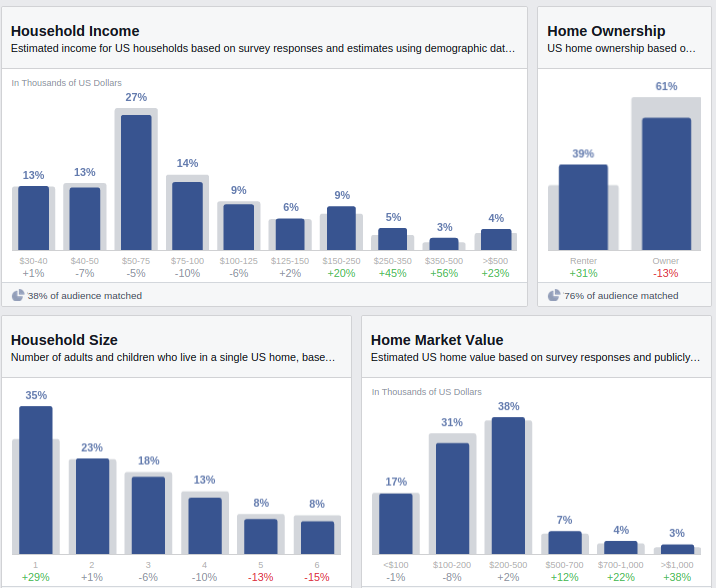
We can also see that a majority of the people in the audience own a home and earn $50-75 thousand dollars a year.
It’s interesting, however, that 31% more people in this audience rent, rather than own a home. If you wanted to really narrow down your targeting, you could focus on users that rent a home and ignore those who own one.
What’s more, this audience has a disproportionate number of people who earn 100K plus, alluding to the fact that they might be business owners.

And, finally, we can see that the audience we have targeted spends 117% more on business purchases than the rest of Facebook.
This is reassuring if you’re selling a course to business owners, since your course could be classified as a ‘Business purchase.’
Turning That Information into Highly Targeted Ads
So, as a result of the information provided by Facebook Audience insights, we now know how to target our ads. We have also inadvertently created the basics of a buyer persona.
If we were looking to create a Facebook Ads course that taught people how to build a list, here is an example of how we might build a persona to target with our ad.
- Age: 21-55
- Gender: Male & Female
- Education: College, Grad
- Relationship: Married, Single
- Location: New York, Los Angeles, Atlanta, San Francisco, Chicago
- Job Title: Management, Sales and Administrative
- Interests: Rebelmouse, Life on Fire, Gary Vaynerchuk, Hubspot, Hootsuite, Social Media Examiner, Ali Brown
- Device: Desktop and Mobile
- Income: 50k Plus
You could save this audience, so that you can use it when creating your Facebook Ads.
However, if you do it like that, you might accidentally include some interests that aren’t worth targeting.
After all, it might turn out that people who like Rebelmouse really don’t like courses on Facebook Ads.
Using the raw data, therefore, provides you with a chance to be more selective in your targeting.
ii) How to use Audience Insights when have absolutely no idea who your ideal customer is.
The Audience Insights tool can still help you realize who your ideal customer is, even if you’re struggling to come up with a buyer persona.
Provided that you have a Facebook Fan Page with a minimum of 1,000 fans, the Audience Insights tool can help you learn more about the people who are attracted to your business.
Audience insights differs from the well known Page Insights.
To explain it in simple terms – Page Insights tells you how people are interacting with your page. Audience Insights tells you who is interacting with your page.
To gather data for a Fan Page, go to the Audience Insights page and click on Create New.
![]()
Once done, click on the ‘People Connected to your Page’ option when the pop-up appears.

Then, under the pages tab on the left, enter the name of your page ib 2017en.

You’ll then be supplied with a data set that will tell you who is actually interacting with your page.
As we did earlier, you can then use that information to create a highly targeted ad.
iii) Combining Audience Insights with a mailing list.
If you currently have an email list, you can also use that to work out who your target market is. Thanks to the Custom Audiences feature, you can upload your email list to Facebook.
If you want to upload your email list and use it to create an audience on Facebook, go the Power Editor on Facebook.
Then click on ‘Audiences.’

Select ‘Create a Custom Audience’ and choose’ Customer List.’
Note that you can use phone numbers and Facebook users IDs, too.
I only mentioned e-mail addresses as this is often the easiest thing to obtain and also the easiest for Facebook to cross reference. Nearly everyone puts in their email address, but less people put in their phone number when signing up for Facebook.
In order for Facebook to do this effectively, the e-mail list you upload needs to have at least 1000 monthly active people on it that use Facebook.
This won’t work otherwise.
It might take Facebook a few days to analyze your audience.
When it’s done, you’ll need to go back to the Audience Insights page and click on ‘Open.’ There, you’ll be able to access the ‘Custom Audience.’

Once done, you’ll be able to gather data on who your customer actually is.
Of course, you don’t have to go through this step. You could just target you’re mailing list directly when creating an ad and choosing your audience.
However, there’s no need to limit yourself.
If you can create a buyer persona using your email list, you can then target many more people on Facebook using that buyer persona.
You’re Not Paying Enough per Click
Competition is rising on Facebook. A recent study found that, in 2015, businesses spent 122% more on ad units than they did in 2014.
If you’re not willing to spend the right amount of money, your ads won’t be seen and your campaign will fail — no matter how good your targeting is.
Those who are new to Facebook Ads should use the CPC model for buying ads, as it’s easier to work out how much each conversion is costing you and how your ads are actually performing. You’ll also stop yourself from burning through your budget, should your ads be poor performers.
Facebook is a bidding platform. That means that when buying ads, you’re competing against other advertisers who are targeting the same audience.
The advertiser who is willing to pay the most gets the most exposure.
If you spend too little, you get minimal exposure and, hence, your ads won’t lead to sales.
How do you know if your Facebook campaign is struggling with this problem?
If you’re still not getting clicks, despite accurate targeting and impressive ads, low bids could be the root of the problem. This is because of the reasons mentioned above. Lows bids = Low exposure.
When it comes to deciding how much you want to pay per click, you have two options windows 10 update herunterladen startet nicht. You pick how much you want to pay, or you let Facebook decide for you.

If your campaign is failing because your ads aren’t getting enough clicks, try setting your own bids. So, in the example above you might set a bid of $0.66.
Because of how Facebook’s bidding platform works, you won’t necessarily be paying $0.66 cents for every click that you receive.
The $0.66 just represents a maximum you’re willing to pay for one click. What will happen is that you’ll just end up bidding marginally higher than the previously highest bidder.
Before, the highest bid might have been $0.50. Thanks to your new maximum bid, you’ll potentially end up bidding in the region of $0.51-$0.53, provided that no one is willing to go higher.
There’s one thing you need to remember, however, or else this will all come crashing down, leaving you with no results and a feeling of dejection.
Raising your bid is only worth it if your ad is good. If you raise your bid, but your ad is no good, Facebook will penalize you.
They can tell how good your ad is by looking at its CTR.
On the CPC model, ads with a low CTR make Facebook less money. That’s because fewer people are clicking on it. Facebook is relying on people to click on it so that they can make money.
That is why proper targeting is so vital.
Don’t get too complacent, though, as even targeting can’t save you if you ignore the next point I’m about to make.
Your ads are not click-worthy
Brilliant targeting? Check.
Outbidding your competitors? Check.
Ads still failing? Check…
If you’ve taken care of your targeting and your bidding strategy, the next reason your ads might be failing is because they’re just not click-worthy.
Remember, on Facebook, you’re competing with a lot of visually appealing content. People are looking at pictures of their family, girlfriends and cute kitten videos.
Attention is a scarce commodity on Facebook and it’s up to you to create ads that draw in users like nothing else.
After all, the last thing that people want to see is irrelevant ads.
Even though it’s from 2006, this post from TechDirt puts it succinctly – ‘People don’t hate advertising; they hate bad, intrusive and annoying advertising.’
You need to make sure that your ads don’t fall into this camp.
If they do, nobody will want to engage with your ads. In fact they may just do the opposite and click the ‘I don’t want to see this’ option shown below.
![]()
How do you know if your ads are the problem?
When you are still not getting clicks, even though your targeting is brilliant and your bid is set high, your ads tend to be the main issue.
Let’s take a look at how we can make click-worthy ads that encourage people to click on them.
To keep things simple, we’ll breakdown Facebook Ads into three main components firefox 64 bit.
Be it Newsfeed ads or Sidebar ads, these three components need to be optimized, if you want your ads to work.
The headline
The headline has to capture the attention of the people you’re targeting.
Brilliant ad headlines will do one of two things.
A headline could be designed so that it can ‘enter the conversation that’s taking place in your customers mind’– a term coined by the influential ad man Robert Collier.
A headline might do this by asking a relevant question that’s based on something that is important to the person who is viewing the ad.
For example:
- Struggling to get customers?
- Is no one visiting your website?
- Need someone to help you lose weight?
- Wondering where you should invest your money?
Here is a visual example—

On the other hand, a headline could also be positioned as a statement which clearly defines the value you’re offering.
See the example below where the value proposition is clear? The word ‘free,’ and the fact that it has been entirely capitalized makes it even more enticing.

There are a couple of crucial things that make both headline examples effective. If you want to emulate the power of those ads consider the following—
- Ask a question. Questions make people stop, think and assess their situation in the context of what was asked.
- Use power words. You’ll see the word ‘free’ used in a lot of ads — that’s because it works.
- Use numbers. Numbers grab attention. ‘30-day trial’ is an example of using numbers.
- Be direct. State the result that you can provide in the simplest way possible.
The image
Just by looking at the two ads shown earlier, you can tell that one thing is common. There are pictures of people in both of them. I chose those ads randomly, by the way.
Though not always the case, when you begin to notice a trend like this, it’s often because it works.
Facebook is a visual platform. Posts that have images generate 53% more likes than those that do not. People are on the lookout for images.
If you want high-performing images in your ads, consider using people who are looking at the camera. The ads below should provide a sense of how this works.


You can only have 20% of the image taken up by text. So, you can’t use it to game the character limits.
However, if you’re struggling to stick to this rule, consider moving the text around a bit. Jon Loomer found that he could sometimes get around Facebook’s limitations by doing this.
Either way, it’s not too big a concern as you can surprisingly do a lot with 20%. Take a look at the two ads below —

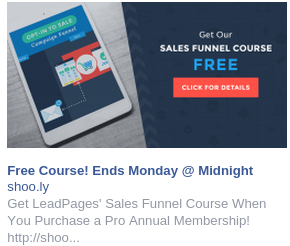
See how the text in the image almost emulates the headline and includes a call-to-action that looks like a button?
This is the kind of stuff that captures attention and encourages people to click on ads.
So what’s the takeaway?
Use images in which people are looking at the camera and try and include some text that amplifies your message herunterladen. This is a starting point, of course, as you’re free to experiment later on.
After you’ve taken care of the headline and the image, your next focus is the copy.
The copy
Copy is the large chunk of text in an ad. It will do a lot of the heavy lifting for you and sell your offer.
It will explain what was described in the headline and will tell people what to do next, in the form of a ‘call-to-action.’
There are several things that you can d,o in order to create compelling copy.
i) Create an effective call-to-action (CTA)
Your CTA needs to tell people what they should do next. It must be encouraging and to the point.
‘Sign up’ or ‘Learn more’ – these are both examples of a CTA.
As with the headline of your ad, your copy should include some power words too.
You’ll need to split test your CTA’s (more on that later). But, for now, just make sure that your ad has one.
Study other ads, so that you can eventually craft a perfect CTA of your own.
ii) Benefits, Benefits, Benefits
Rare is it that features prevail over benefits when trying to convince someone.
Your copy is there to sell. So, you need make sure potential customers are clear on the benefits that will result from having clicked on your ad.
Look at this ad –

The copy is filled with benefits. It’s clear and concise and it explains everything in a simple, easy-to-understand fashion.
Let people know what’s in it for them and how their life will get better as a result of having clicked on the ad.
Don’t make the mistake of trying to be overly inventive. This isn’t the place to be clever – it’s the place to be clear.
iii) A sense of urgency
A call-to-action is a brilliant way of getting people to click on your ad.
You know what can supercharge this effect though?
A sense of urgency.
Let people know how long your offer is going to be open. Let them know the benefits of signing up now.
Of course, don’t lie when utilizing this tactic.
Take a look at some of the image examples above, if you’re looking for some inspiration on how you should implement this tactic.
iv) Social proof
Social proof is another way to put your ad copy on steroids.
If you don’t know what social proof is, it is essentially a way to influence people by letting them know what other people did in a given situation.
You can implement this in your copy by describing how many people already use your product/service.

The image above does this, to some extent. It explains how 30,000 marketers are involved with this event.
Subconsciously, you may assume that this event is worth investing in because so many other people are engaged with it.
As a result, you may feel more inclined to click on the ad.
Is this not enough?
After having followed the tips you’ve read so far your ads might start to work again.
However, your success might not last long. You could still have a Facebook Ad campaign on your hands that is teetering on the edge.
Keep reading to see why din normen.
You’re using the same ad over and over
What normally happens after having driven or walked past a billboard two or three times?
That’s right, you begin to ignore it. It’s like the billboard doesn’t even exist.
Facebook ads are just like billboards. And, just like billboards in the real world, they are prone to the same problem. The technical term for this is ‘ad fatigue.’
It makes sense, given that 25-34-year olds (the target market for many) see 2,094 banner ads per month.
Remember, with Facebook, you’re picking a set group of people who will see you ad. Eventually, that set group of people will grow tired of what you’re showing them.
Because of ad fatigue, you need to therefore change your ads on a regular basis.
‘So, how do we know when we need to change our ads?’ — I hear you ask.

Thankfully, Facebook has provided us a with a few metrics, so that we can tell when this is happening.
One such metric is ‘Frequency.’ This tells us how many times each person in our ‘Reach’ has seen our ad.
It is calculated by dividing Impressions by Reach. In simple terms, it is how many times your ad is shown divided by the number of people it was shown to.
Spiralytics found that ad fatigue set in once a campaign had reached a frequency of 4.
However, Frequency analyzed in isolation can be a hard way to work out whether or not an ad is suffering from ad fatigue. It only tells you how many times a given person has seen your ads.
Therefore, you need to interpret frequency in the context of CTR. If you notice that your CTR is beginning to fall as your frequency rises, you know that ad fatigue is setting in.
As people get used to seeing your ad, they’re less likely to click on it.
You need to be wary of this, because of the reasons discussed earlier. Facebook will charge you more and more if your CTR begins to fall.
If you don’t fix this, you’ll be paying more for ads that don’t bring a return on investment. You need to initiate damage control, as soon as possible. Checking your campaigns twice a day is a good way to stay on top of things.
The next step will teach why you might still be failing, even though you’ve done everything right up until now.
You’re expecting to get it right on the first try
The truth of the matter is this — no matter how good you are at paid advertising, you won’t always get it right on your first go. This rule applies to every campaign that you will ever create.
If you thought that you could just create one ad and then watch the money roll in, you’re mistaken.
More often than not, you’ll need to create multiple variations of a single ad. This is also known as split testing.
The team that managed Obama’s online marketing used split testing to improve conversion rates.
Thanks to split testing, they found that the call to action ‘learn more’ generated 18.6% more sign ups that the default ‘Sign Up.’
They also found out that a picture of Obama with his family performed 13.1% better than the default turquoise image used previously.
There is a post on Adespresso that talks about this invitations birthday available for free download. In that post they show the two images that were tested against each other.

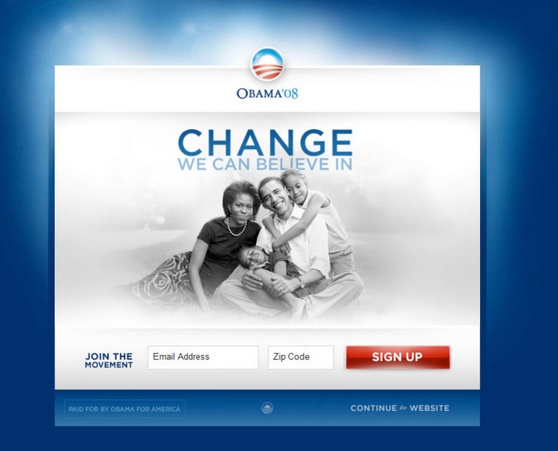
As you can see, nothing else was changed except for the image. By just changing this one element, they found an increase in conversions.
Of course, if you want to look at things with an ‘eagle eye’, then you could argue that they also changed the headline from ‘Get involved’ to ‘ Change we can believe in’.
Though this relates to a landing page, the lessons still apply to Facebook Ads.
When running your own split tests, it’s important that you don’t change the image and the headline simultaneously.
When you change one element at a time, you make it easier to identify what change contributed to a rise in results. You can then use this lesson in your future ad campaigns.
Facebook will organize your ads in the following manner – Campaign – Ad Set – Ads.

Quick tip — when split testing ads, place each of the ads in separate Ad Sets. Ads in the same Ad Set influence the results of each other and can therefore muddy the data that you’re collecting.
The problem is that Facebook might pick out a winner too early and then prevent you from gathering data on how the other ads are performing, with all things being equal.
Here are some of the things that you can test:
- Try other countries. If you offer isn’t geographically limited, you may be able to extend your offer to other countries. This is a good idea, if you have a great ad that is currently suffering from ad fatigue. Target English speaking countries such as the UK, Australia and Canada.
- Test different images. If you test images and nothing else, there’s a big chance that you’ll make some major improvements. Create the same ad, but apply 8-10 different image variations.
- Use different headlines. Follow the same instructions provided for images- Same ad, 8-10 headline variations. You could try experimenting with statement vs. question, for example.
- Experiment with copy. Continue the approach used for images and headlines. Consider using social proof.
- Target different devices. Ignore the hype surrounding mobile. Your offer might work better if you focus only on desktop devices. Test and see what happens.
- Ad Type. Are you only using Sidebar ads? Your campaign might be more successful if you use Newsfeed ads. Already using Newsfeed and Sidebar ads? Try video Newsfeed ads instead.
- Targeting. Try targeting different interests. Get comfortable, as well, with some of the more advanced targeting features on Facebook. A good one to take a look at is ‘Lookalike Audiences.’
If your offer is limited to one country and the audience is small, you may want to focus on split testing your targeting first.
By targeting different audiences, you make it so that you don’t end up bidding against yourself for the same ad spot.
When you find a winning ad that brings a great return on investment, you need to immediately spend more money on it super rtl herunterladen.
Remember that you only have a certain amount of time to make the most out of a winning ad before ad fatigue chokes off your results.
Conclusion
If your ad campaigns are dying on you, the knowledge you picked up in this article should help bring them back to life.
Don’t forget that you can’t just take an ad-centric approach. The page that you’re sending people to needs to convert well, also. But, if you abandon the principles discussed earlier, people won’t even reach the page you want to promote.
Do you want to know the one principle that rises above all the ones mentioned?
Sorry, there isn’t one.
The targeting, bid price, ‘click-worthiness’ of the ad and your ability to split test – they all need to come together if you want your campaign to succeed.
Combine them all and I’m sure you’ll nail it.
What have you done in the past to revive a campaign that wasn’t working?



